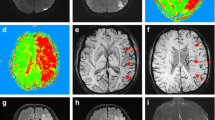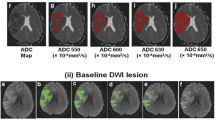Abstract
Objective
In acute ischemic stroke, the number and distribution of lesions on diffusion weighted imaging (DWI) have been shown to give clues to the underlying pathogenetic mechanisms. The objective of this study was to determine whether lesion features on DWI differ between stroke due to large artery atherosclerosis (LAA) and cardioembolism (CE), and to assess the role of apparent diffusion coefficient maps (ADC).
Methods
We retrospectively studied 83 consecutive patients with stroke caused by either LAA (n = 40) or cardioembolism (n = 43). DWI lesions were characterized by number, size, distribution (i. e. lesion pattern) and signal intensity on ADC maps. In part A, all hyperintense DWI lesions regardless of their ADC were compared. In part B, only hyperintense DWI lesions with hypointense appearance on ADC maps (i. e. acute lesions) were assessed.
Results
Part A: The frequency of multiple hyperintense DWI lesions (LAA: 28/40, CE: 21/43; p < 0.05) and the lesion number (LAA 4.7 ± 4.9; CE: 3.1 ± 4.7; p = 0.01) were higher in LAA–patients. Involvement of >1 circulation (i. e. anterior plus posterior or bilateral anterior circulations) was present in 5 LAA–patients (13 %) and 4 CE–patients (9 %). Lesion size did not differ between LAA–stroke (35.1 ± 33.7 mm) and CE–stroke (35.4 ± 27.8 mm). Part B: Multiple hyperintense DWI lesions with low ADC occurred in 23/40 LAA–patients and in 15/43 CE–patients (p < 0.05). Lesions in >1 circulation occurred only in CE–stroke (n = 3; 7%) and never in LAA–stroke.
Conclusions
(1) Multiple ischemic lesions occur significantly more often in LAA–stroke than in CE–stroke. (2) ADC maps are important in the comparison of DWI lesion patterns; DWI lesions in > 1 circulation can only be assigned to a cardioembolic etiology if they appear hypointense on ADC maps.
Similar content being viewed by others
References
Adams HP Jr, Bendixen BH, Kappelle LJ, Biller J, Love BB, Gordon DL, Marsh EE (1993) Classification of subtype of acute ischemic stroke. Definitions for use in a multicenter clinical trial. TOAST. Trial of Org 10172 in Acute Stroke Treatment. Stroke 24:35–41
Altieri M, Metz RJ, Muller C, Maeder P, Meuli R, Bogousslavsky J (1999) Multiple brain infarcts: clinical and neuroimaging patterns using diffusionweighted magnetic resonance. Eur Neurol 42:76–82
Baird AE, Lovblad KO, Schlaug G, Edelman RR, Warach S (2000) Multiple acute stroke syndrome: marker of embolic disease? Neurology 54:674–678
Bamford J, Sandercock P, Dennis M, Burn J, Warlow C (1991) Classification and natural history of clinically identifiable subtypes of cerebral infarction. Lancet 337:1521–1526
de Bray JM, Pasco A, Tranquart F, Papon X, Alecu C, Giraudeau B, Dubas F, Emile J (2001) Accuracy of color– Doppler in the quantification of proximal vertebral artery stenoses. Cerebrovasc Dis 11:335–340
DeWitt LD, Rosengart A, Teal PA (1993) Transcranial Doppler Ultrasonography: Normal Values. In: Babikian VL,Wechsler LR (eds) Transcranial Doppler Ultrasonography. Mosby, St. Louis, Missouri, pp 29–38
Engelter ST, Wetzel SG, Radue EW, Rausch M, Steck AJ, Lyrer PA (2004) The clinical significance of diffusionweighted MR imaging in infratentorial strokes. Neurology 62:574–580
Kang DW, Chalela JA, Ezzeddine MA, Warach S (2003) Association of ischemic lesion patterns on early diffusion–weighted imaging with TOAST stroke subtypes. Arch Neurol 60:1730–1734
Kang DW, Chu K, Ko SB, Kwon SJ, Yoon BW, Roh JK (2002) Lesion patterns and mechanism of ischemia in internal carotid artery disease: a diffusionweighted imaging study. Arch Neurol 59:1577–1582
Keir SL, Wardlaw JM, Bastin ME, Dennis MS (2004) In which patients is diffusion– weighted magnetic resonance imaging most useful in routine stroke care? J Neuroimaging 14:118–122
Koennecke HC, Bernarding J, Braun J, Faulstich A, Hofmeister C, Nohr R, Leistner S, Marx P (2001) Scattered brain infarct pattern on diffusionweighted magnetic resonance imaging in patients with acute ischemic stroke. Cerebrovasc Dis 11:157–163
Lansberg MG, Norbash AM, Marks MP, Tong DC, Moseley ME, Albers GW (2000) Advantages of adding diffusionweighted magnetic resonance imaging to conventional magnetic resonance imaging for evaluating acute stroke. Arch Neurol 57:1311–1316
Lee PH, Bang OY, Oh SH, Joo IS, Huh K (2003) Subcortical white matter infarcts: comparison of superficial perforating artery and internal borderzone infarcts using diffusion–weighted magnetic resonance imaging. Stroke 34:2630–2635
Moseley ME, Cohen Y, Mintorovitch J, Chileuitt L, Shimizu H, Kucharczyk J, Wendland MF, Weinstein PR (1990) Early detection of regional cerebral ischemia in cats: comparison of diffusion– and T2–weighted MRI and spectroscopy. Magn Reson Med 14:330–346
Roh JK, Kang DW, Lee SH, Yoon BW, Chang KH (2000) Significance of acute multiple brain infarction on diffusionweighted imaging. Stroke 31:688–694
Schaefer PW, Hunter GJ, He J, Hamberg LM, Sorensen AG, Schwamm LH, Koroshetz WJ, Gonzalez RG (2002) Predicting cerebral ischemic infarct volume with diffusion and perfusion MR imaging. AJNR Am J Neuroradiol 23:1785–1794
Schlaug G, Siewert B, Benfield A, Edelman RR, Warach S (1997) Time course of the apparent diffusion coefficient (ADC) abnormality in human stroke. Neurology 49:113–119
Schwamm LH, Koroshetz WJ, Sorensen AG, Wang B, Copen WA, Budzik R, Rordorf G, Buonanno FS, Schaefer PW, Gonzalez RG (1998) Time course of lesion development in patients with acute stroke: serial diffusion– and hemodynamic–weighted magnetic resonance imaging. Stroke 29:2268–2276
Singhal AB, Topcuoglu MA, Buonanno FS (2002) Acute ischemic stroke patterns in infective and nonbacterial thrombotic endocarditis: a diffusionweighted magnetic resonance imaging study. Stroke 33:1267–1273
Szabo K, Kern R, Gass A, Hirsch J, Hennerici M (2001) Acute stroke patterns in patients with internal carotid artery disease: a diffusion–weighted magnetic resonance imaging study. Stroke 32:1323–1329
Takahashi K, Kobayashi S, Matui R, Yamaguchi S, Yamashita K (2002) The differences of clinical parameters between small multiple ischemic lesions and single lesion detected by diffusion–weighted MRI. Acta Neurol Scand 106:24–29
Tatu L, Moulin T, Bogousslavsky J, Duvernoy H (2001) Arterial territories of the human brain. In: Bogousslavsky J, Caplan LR (eds) Stroke Syndromes. Cambridge University Press, Cambridge, United Kingdom, pp 375–404
Warach S, Benfield A, Edelman RR (1995) Time course of abnormal apparent diffusion coefficient in human stroke. Proc Soc Magn Reson 1:82
Warach S, Chien D, Li W, Ronthal M, Edelman RR (1992) Fast magnetic resonance diffusion–weighted imaging of acute human stroke. Neurology 42:1717–1723
Warach S, Gaa J, Siewert B, Wielopolski P, Edelman RR (1995) Acute human stroke studied by whole brain echo planar diffusion–weighted magnetic resonance imaging. Ann Neurol 37:231–241
Author information
Authors and Affiliations
Corresponding author
Additional information
Funding: This study was supported, in part, by the Basel Stroke Fund. S.Wetzel was supported, in part, by a grant from the Swiss National Science Foundation (grant 3200–066634).
Rights and permissions
About this article
Cite this article
Bonati, L.H., Lyrer, P.A., Wetzel, S.G. et al. Diffusion weighted imaging, apparent diffusion coefficient maps and stroke etiology. J Neurol 252, 1387–1393 (2005). https://doi.org/10.1007/s00415-005-0881-1
Received:
Revised:
Accepted:
Published:
Issue Date:
DOI: https://doi.org/10.1007/s00415-005-0881-1




